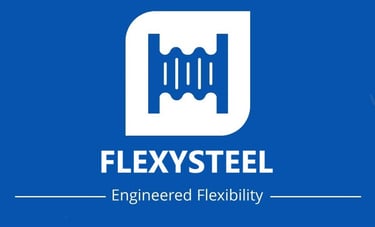METAL EXPANSION JOINTS FOR ACC PROJECTS
Flexysteel specializes in the design and manufacturing of metal expansion joints engineered for piping systems in Air-Cooled Condenser (ACC) projects.
These expansion joints consist primarily of flexible metallic bellows, which are designed to absorb thermal expansion, mechanical vibrations, and misalignments within the piping network, while maintaining system pressure integrity and ensuring uninterrupted flow of the working medium.
The main types of these expansion joints and their typical areas of application can be summarized as follows:
Tied Lateral Expansion Joints for ACC risers
Hinged Angular Expansion Joints ACC risers
Pressure Balanced Expansion Joints for Turbine Connections
Dog & Bone Expansion Joints for Turbine Connections
Tied Lateral Expansion Joints
This model is primarily designed to absorb lateral movements across all planes within the piping system. Additionally, through specific tie rod configurations and optimized design or orientation, the unit can also accommodate limited axial and angular movements.
The lateral deflection capacity of the expansion joint is determined by the angular flexibility of each bellows element and the effective length of the central (spool) pipe. By simply adjusting the length of the spool section, the overall lateral movement capability can be either increased or reduced as required by system conditions.
Furthermore, the thermal expansion of the central pipe is compensated by the bellows, ensuring the integrity and flexibility of the assembly under varying temperature conditions.
Hinged Angular Expansion Joints
These expansion joints consist of a single bellows element equipped with welded ends or flanged connections, integrated with a hinged (articulated) support system that permits angular movement in a single plane only.
The hinge mechanism is specifically engineered to withstand the full pressure thrust, effectively isolating the connected piping and anchors from pressure-induced loads. Standard hinged expansion joints do not accommodate axial movement. However, certain modified hinge assemblies can be supplied with elongated (slotted) hinge pin holes to allow for limited axial displacement.
It should be noted that these slotted-hinge designs are not capable of restraining pressure thrust forces; therefore, adequate external anchoring and guiding systems must be incorporated into the piping layout to ensure safe operation.
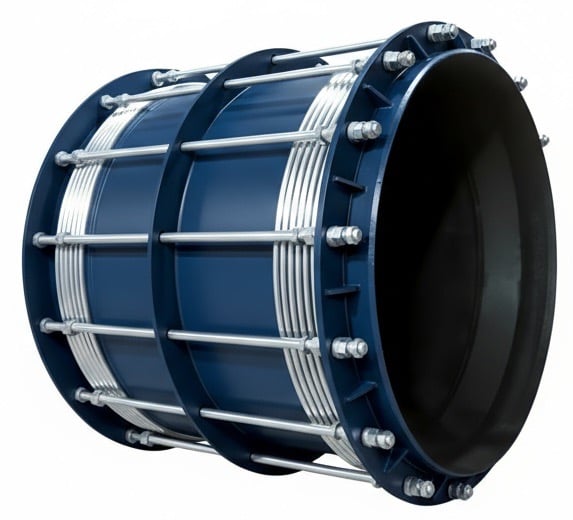

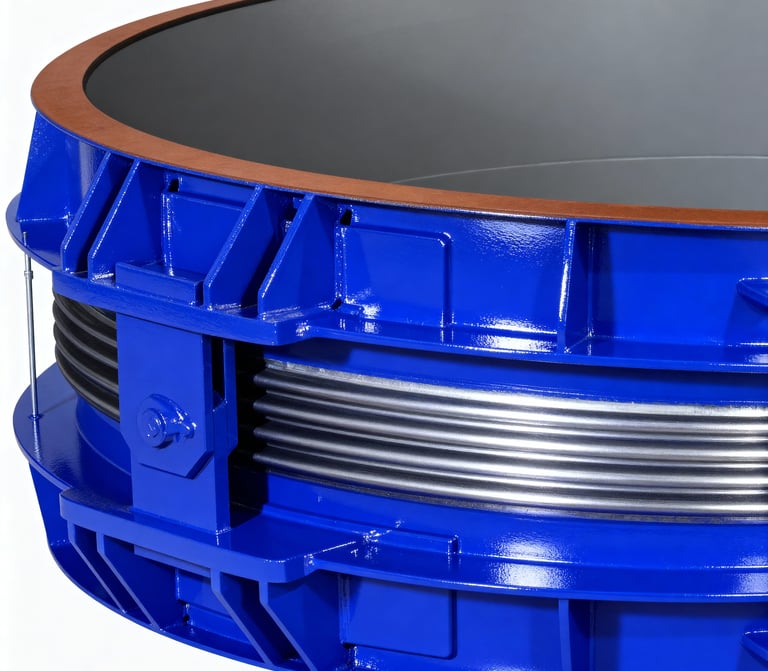

Pressure Balanced Expansion Joints
A Pressure Balanced Expansion Joint (PBEJ) is specifically designed to absorb both axial and lateral movements while eliminating the pressure thrust effect typically transmitted through the piping system.
This is achieved by incorporating an additional balancing bellows, which is exposed to the same internal line pressure as the main bellows. The resulting counteracting force is equal in magnitude and opposite in direction to the thrust acting on the main bellows. By mechanically linking these bellows assemblies, the net pressure thrust within the unit is neutralized.
Pressure Balanced Expansion Joints are utilized in applications similar to those for axial or lateral expansion joints, but they provide the distinct advantage of isolating connected equipment from the pressure-induced axial loads. This feature is particularly critical when connecting piping to turbines, compressors, or other sensitive equipment that cannot tolerate additional mechanical loads.
The only forces transmitted to the adjacent equipment are the spring forces associated with the movement of the line and balancing bellows. Because of this self-compensating design, Pressure Balanced Expansion Joints can be installed between intermediate anchors, eliminating the need for major anchoring structures or heavy support systems.
Dog & Bone Expansion Joints
The Dog Bone Type Expansion Joint serves as a flexible connection between the steam turbine outlet and the condenser inlet. This configuration is extensively applied in power generation facilities, being the most commonly utilized turbine-to-condenser expansion joint design.
Its primary engineering function is to compensate for differential thermal expansion occurring between the turbine and condenser assemblies during operation.
The Dog Bone geometry provides high flexibility while maintaining low spring rates, thereby minimizing reaction forces and bending moments transmitted to the turbine exhaust flange. By effectively accommodating thermal growth and mechanical vibration, the Dog Bone Expansion Joint ensures system integrity, operational reliability, and extended service life of both the turbine and condenser components.
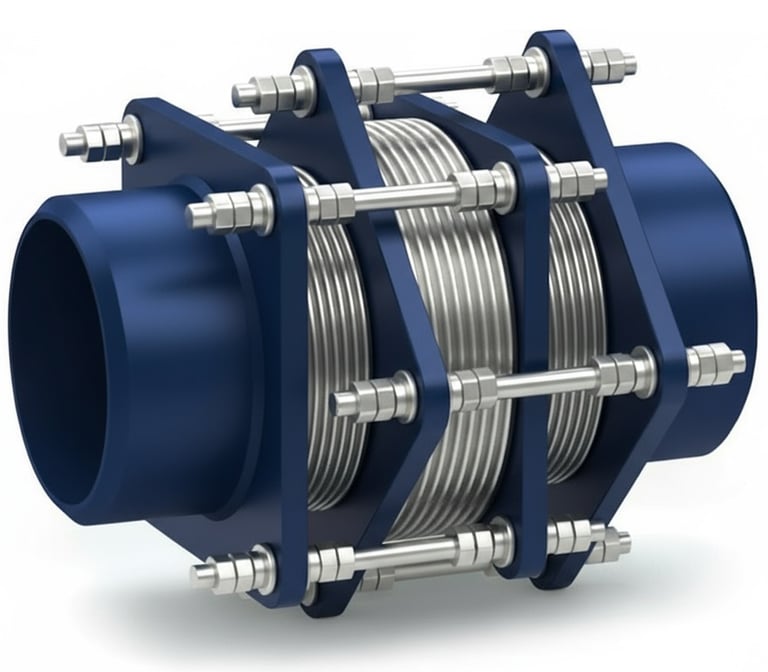

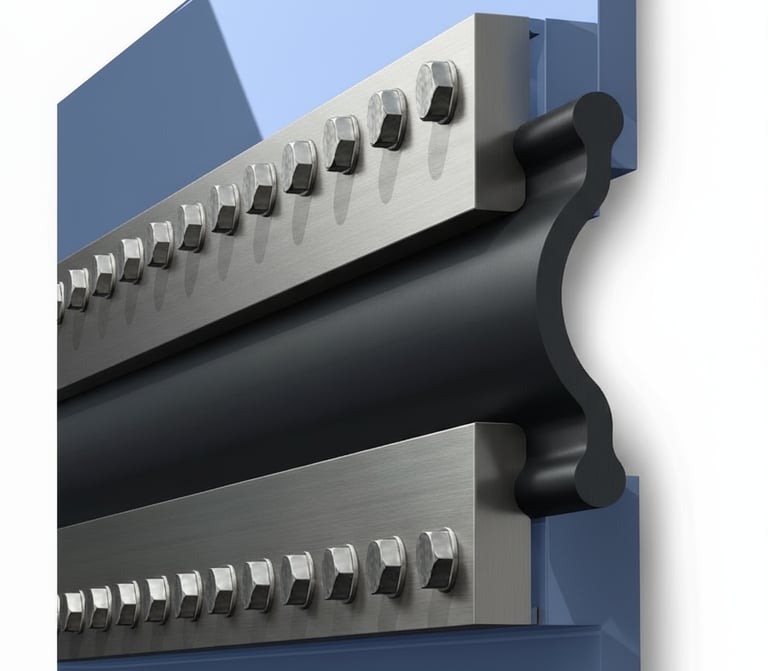

The flexibility characteristics of an expansion joint are quantified by its stiffness (spring rate), which is directly influenced by the bellows geometry — including convolution shape, pitch, height, wall thickness, number of plies, and material properties. Flexysteel designs and manufactures bellows and expansion joints in full compliance with recognized international design and fabrication codes, such as those listed below:
EJMA, Edition:11
EN 14917:A1
ASME Sec. VIII. Div.1- App:26
Expansion joints are integral components of pressurized piping systems, designed to operate safely under internal pressure and cyclic mechanical loading. Accordingly, their design, fabrication, and testing are carried out in full compliance with the European Pressure Equipment Directive (PED 2014/68/EU), as well as relevant American design codes and standards, including:
ASME Boiler and Pressure Vessel Code, Section VIII Division 1 or Division 2 – Design and construction of pressure-retaining components.
ASME B31.1 – Power Piping – Applicable to high-pressure and high-temperature piping systems in power plants.
ASME B31.3 – Process Piping – Applicable to process and chemical plant installations.
This ensures that each expansion joint manufactured by Flexysteel meets the highest standards of safety, reliability, and regulatory compliance for use in critical pressurized systems.
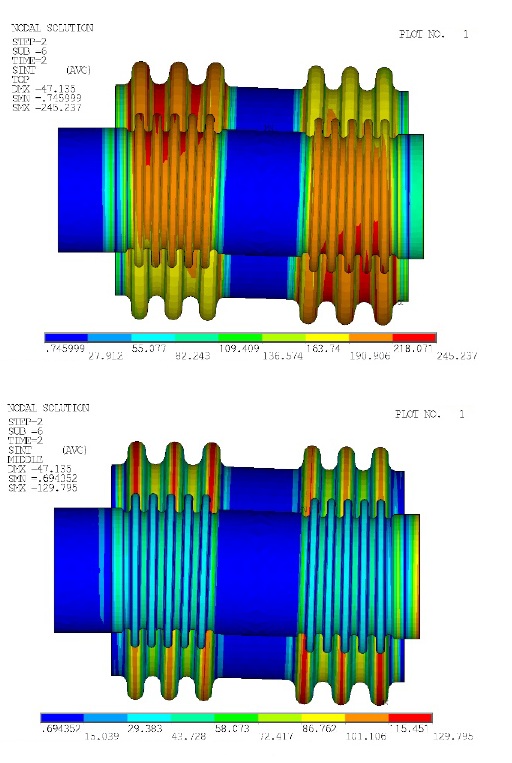

Design & Construction:
Design Verification:
In certain cases, it may not be feasible to verify the pressure integrity of an expansion joint solely through the analytical methods defined in conventional design standards.
This limitation typically arises when the geometry of the expansion joint is highly complex, or when additional design optimization is required beyond the scope of standard analytical formulas. In such situations, Flexysteel performs advanced Finite Element Analysis (FEA) to evaluate and validate the structural integrity of the expansion joint under specified operating conditions.
Through detailed nonlinear, thermal, and fatigue simulations, critical parameters such as stress distribution, deformation behavior, and stability are accurately assessed, ensuring full compliance with applicable design codes and safety requirements.
Flexysteel utilizes its extensive expertise in metal bellows engineering to achieve optimal mechanical performance, fatigue resistance, and extended service life under demanding operating conditions. Expansion joints are critical components in piping systems, designed to absorb thermal growth, mechanical vibration, and system misalignment. By introducing the necessary flexibility at predefined points, they effectively reduce stress concentrations that would otherwise occur within the pipeline or connected equipment.
A strong commitment to quality has always been a core element of Flexysteel’s mission. The company is recognized not only for its superior product reliability and performance, but also for its modern, fully integrated manufacturing facilities.
Over the past 15 years, Flexysteel’s engineering team has designed and manufactured more than 10,000 customized expansion joints, each tailored to meet specific operational and environmental requirements across various industries.
The company’s production capabilities can be summarized as follows:Size: Up to OD 6000mm
Lifting Capacity: 20 Tons
Pressure: Up to 100 Bar
Temperature: Up to 800 C˚ (Austenitic Steels), 900 C˚ (Nickel Alloys)
Flexysteel’s production facilities are fully capable of welding a wide range of materials, including high-alloy alloys, starting from a minimum thickness of 0.25 mm
Welding:
As Flexysteel frequently participates in projects where expansion joints are critical components, we recognize the essential role of comprehensive supporting documentation. Accordingly, project deliverables typically include:
Detailed quotations specifying scope, materials, and technical requirements,
Supporting calculations to validate design and performance criteria,
Extensive quality control protocols, including inspection and testing procedures,
Traceable documentation for each stage of manufacturing and assembly.
Flexysteel’s welding specialists hold at minimum International Welding Inspector (IWI) certification, enabling them to conduct in-process welding inspections in compliance with international standards.
Furthermore, Flexysteel is fully capable of preparing Welding Procedure Specifications (WPS) and Welding Procedure Qualification Records (WPQR) in accordance with multiple international welding codes such as EN 15600 series, ASME sec IX.
Welding operations are performed using a combination of automated and manual processes, strictly in accordance with approved Welding Procedure Specifications (WPS), which are certified by Flexysteel’s welding specialists and endorsed by independent third-party inspectors.
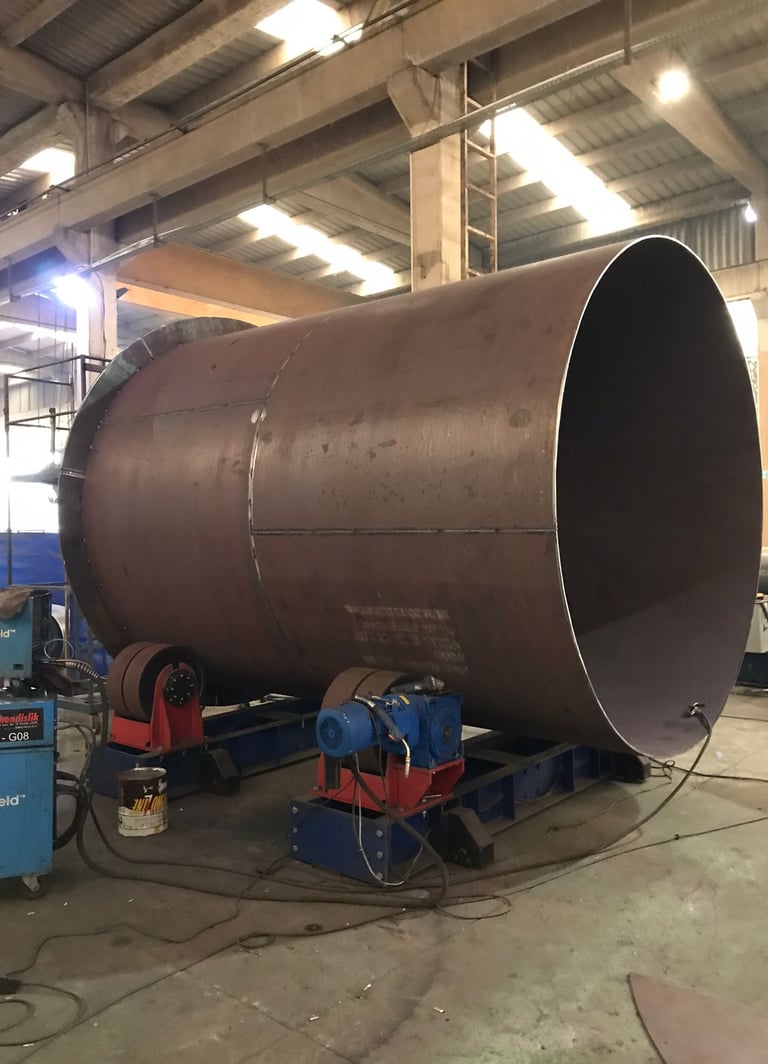

Manufacturing Capacity
Typical Quality Tests Include:
Destructive Tests:
Life Cycle Testing – to validate operational durability and fatigue performance.
Burst Testing – to verify the structural integrity under extreme internal pressure, e.g., for vessels and offshore platforms.
Non-Destructive Tests (NDT):
Visual Inspection (VT)
Dye Penetrant Testing (PT)
Radiographic Examination (RT)
Magnetic Particle Testing (MT)
Ultrasonic Testing (UT)
Hardness Testing
Positive Material Identification (PMI) – for all material grades and applications.
Proof Tests:
Air Leak Test
Helium and Formier Gas Leak Test
Hydrostatic Pressure Test – applicable to all systems and operational conditions.
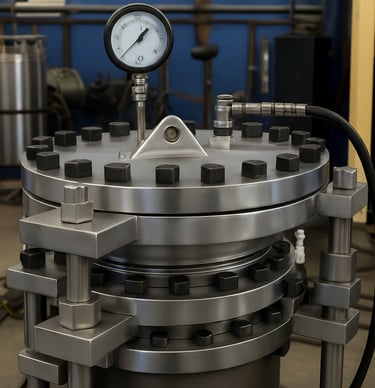

ITP & Testing
The Inspection and Test Plan (ITP), generated by Flexysteel’s Quality Management System, ensures that all stages of manufacturing include appropriate inspection points, including Hold and Witness points as required.
Depending on the applicable manufacturing codes, project specifications, operating media, and classification society rules, Flexysteel conducts a comprehensive range of quality tests, including destructive, non-destructive, and proof testing. All tests may be witnessed by third-party inspectors, in accordance with customer and classification requirements.
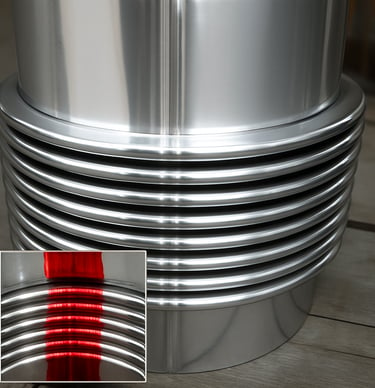

Get in Touch
Head Office:
HH Exclusive Offices
Arnavutkoy merkez Mah.
Eski Edirne Cad, No:1233C
Arnavutkoy/Istanbul
Tel: +90 (0) 541 5819011
e-mail:info@flexysteel.com
European Sales Office:
Ground Floor, 71 Lower Baggot Street
Dublin2, Co. Dublin, D02.
P593, Ireland
Tel: +353 (0) 87 1934059
e-mail: sales@flexysteel.com
UK Sales Office:
16 Saberton Close Redbourn
St.Albans AL3 7DS UK
Tel:+44 (0) 77 21665928
e-mail: uk@flexysteel.com
Manufacturing Plant:
29 Ekim Mahallesi, Karakaya Sokak
No:18, 35878 Yazıcıbaşı
35875 Torbalı/İzmir

